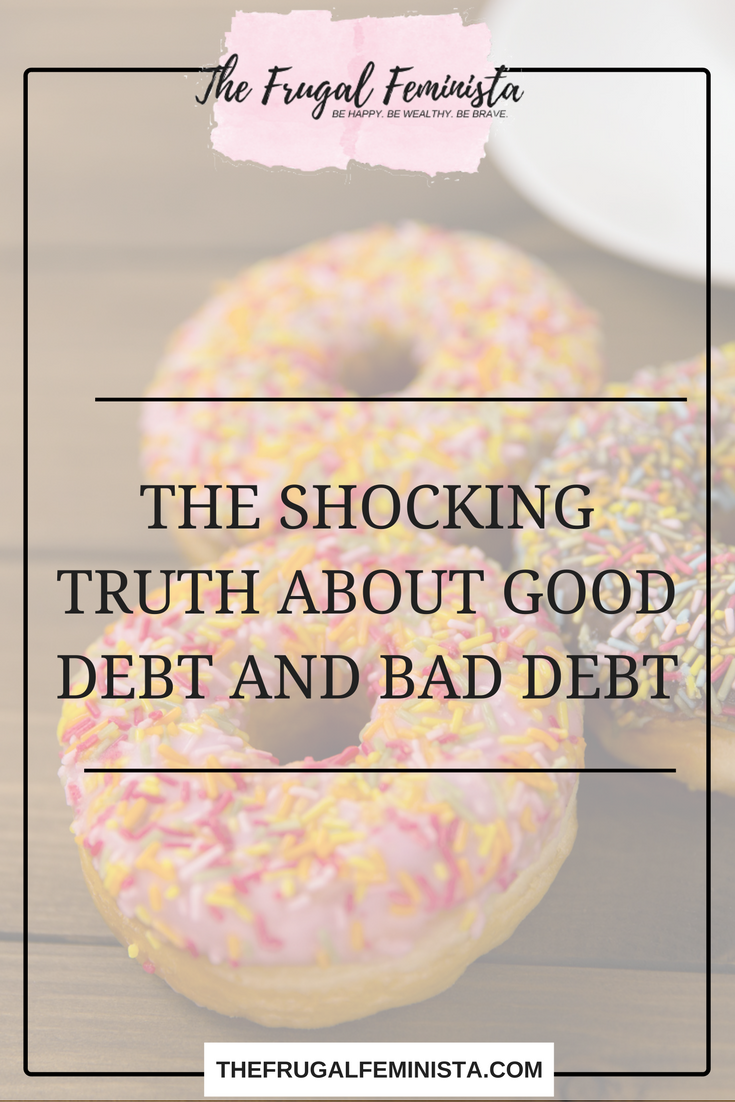 Is there really such a thing as good debt? You’ve probably heard the terms good debt and bad debt, but what do they really mean? Can any debt really be good? Many use the term good debt to refer to a loan used to purchase something that will appreciate or increase in value e.g. student loans and mortgages. Subsequently those are the two largest causes of debt in the United States. Bad debt is used to refer to money borrowed to purchase consumer items or items that depreciate in value e.g. clothes, a car, or electronics. Let’s go more in depth in the comparison of good versus bad debt and get three tips to reduce your debt.
Is there really such a thing as good debt? You’ve probably heard the terms good debt and bad debt, but what do they really mean? Can any debt really be good? Many use the term good debt to refer to a loan used to purchase something that will appreciate or increase in value e.g. student loans and mortgages. Subsequently those are the two largest causes of debt in the United States. Bad debt is used to refer to money borrowed to purchase consumer items or items that depreciate in value e.g. clothes, a car, or electronics. Let’s go more in depth in the comparison of good versus bad debt and get three tips to reduce your debt.
Good Debt:
Student loans are often considered as good debt for a couple of reasons. One, you’re more likely to receive a higher paying job with a college degree. Therefore, your education is considered to appreciate in value. College graduates earn 2-3 times more than individuals with high school diplomas. This can equate to a difference of about $1,000,000 over a lifetime. By obtaining a college degree you can increase your earning potential by $1,000,000 over your life, seems like a great four year investment.
The second reason student loans are considered good debt is student loans generally have low interest rates. Interest rates on student loans can vary between three and eight percent. For these reasons many people would tell you to wait to pay off student loans. However, I believe that you should wait to a degree to pay off student loans. See my article on Bobby Finance to see how to pay off your student loans faster and why. It’s still debt after all.
As for mortgages, there are a couple reasons why such loans are considered good debt as well. One, your home is likely to increase in value by the time you are ready to sell it. Therefore you would make money from your investment at this time. Also, if you completely payoff your mortgage then your home is a great asset as you can sell it and receive the amount of it’s current value. Two, you receive tax breaks when you own a home. If your home is valued at less than one million dollars, you can receive tax breaks on the interest charged on your mortgage payments. You can also receive tax breaks on other home expenses, check with your financial advisor and tax preparer.
Bad Debt:
Bad debt usually stems from credit cards and car loans. The average American household owes over $7,000 in credit card debt. Most of the items purchased with credit cards are items that depreciate in value, they lose value over time. Also, we all know a vehicle depreciates over time. These are items are not true assets as you will not get more money than you paid for them should you decide to sell them at a later date. Your selling price will be lower than the price you paid for it for all items that make up bad debt.
Bad debt is often easy to rack up. It’s accumulated in small sums such as paying for groceries, a restaurant bill, clothes, electronics etc. Before pulling out that plastic, truly consider if it’s worth it to pay that amount and the extra money you will pay in interest fees. Maintaining a lifestyle that is within your means is key to minimizing bad debt. This will allow you to stay in control of your debt and your credit. However, if you already have debt how do you get rid of it? Below are three tips to get you started reducing your debt.
Take these 3 steps to reduce your debt:
1) Create a snapshot. List how much you owe and to whom. This is an important first step, since once you can clearly see how much you total debt you have you can create a realistic-efficient plan to pay off the debt.
2) Prioritize. Determine which debt you will tackle first. Start with the debt that has the lowest amount, which is usually also a credit card with a high interest rate. Aggressively pay this debt off first to give yourself a boost and maintain your motivation to eliminate your debt. Continue making the minimum payments on the other debt. Once you’ve paid off the smallest debt then go to the next smallest and aggressively pay that off and so on until you’ve paid off all your debt.
3) Learn about it. Educate yourself on how credit works and the ins and outs of credit cards and loans. This will help you avoid interest fees and other fees that compound on debt. You will also be less likely to fall into the trap of building up more debt.
Although student loans and mortgages are termed good debt you don’t want to let them linger. Sure, pay off the bad debt first. Above you learned bad debt can get out of control quickly and does not add additional financial value so it makes sense to keep it at a minimum and pay it off quickly. However, “good debt” is still debt and the faster you pay off your mortgage and student loans the less you will pay in interest fees on the borrowed money. You’ll save thousands of dollars by aggressively paying off your student loans and mortgages when all you have left is “good debt.”
Maria James helps busy professionals take control of their money and live a world-class lifestyle by creating money strategies for finance management and growth. You can reach her at info@pocketofmoney.com.










